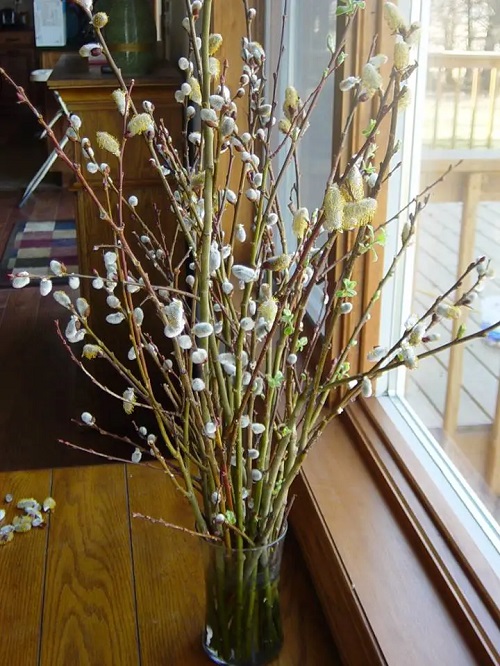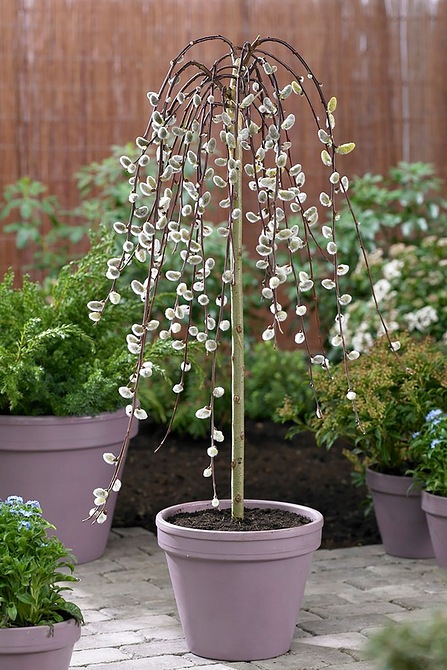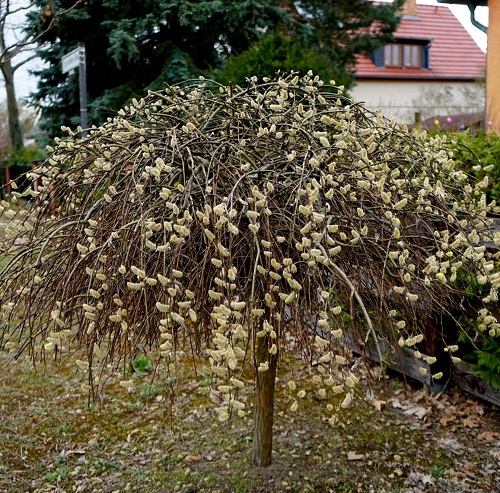Learn Growing Pussy Willow with easy tips and techniques. This shrub is perfect for both beginners and experienced gardeners.
Pussy Willow is a popular shrub known for its soft and fuzzy catkins that appear in late winter and early spring. This hardy plant can be grown in a variety of conditions and is relatively easy to care for.
Here is How to Grow Big Basil Plant Like a Shrub for Unlimited Harvest
What is Pussy Willow?
The Pussy Willow plant, scientifically popular as Salix discolor, is a deciduous shrub that belongs to the Salicaceae family. Pussy Willow is native to northern North America, Europe, and Asia, along with wetland areas, riverbanks, and in damp woodland habitats.
It is a medium-growing shrub that can achieve a height of up to 10-20 feet (3-6 meters) tall. Pussy Willow has slender, flexible branches full of soft, silvery-gray catkins. The catkins, which give the plant its name, resemble fuzzy cat paws or “pussy willows.”
People associate these plants with the arrival of spring. They are also common in floral arrangements and decorations. In some cultures, they symbolize renewal, fertility, and good fortune.
Types of Pussy Willow
There are several types of Pussy Willows (Salix species) that you can consider growing. Here are some popular and commonly cultivated varieties:
- Salix discolor: Features silver-gray catkins that are fuzzy and prominent. It is a hardy plant and adapts well to various growing conditions.
- Salix caprea: This species produces large, fluffy catkins in silver-white or creamy-yellow in color. It is a fast-growing shrub that can reach heights of 15-25 feet (4.5-7.5 meters).
- Salix chaenomeloides: This Japanese Pussy Willows species has red branches and pink-white or yellowish-white catkins.
- Salix gracilistyla: This species has vibrant pink or reddish-purple catkins. It is a smaller shrub, typically reaching heights of 4-8 feet (1.2-2.4 meters).
- Salix purpurea ‘Nana’: This dwarf variety produces small, round, purple catkins. It is suitable for smaller gardens or containers.
Here are Beautiful Types of Echinopsis
Propagating Pussy Willow

Using stem cuttings is the easiest and fastest method to grow Pussy Willows plants.
- Take cuttings in early spring before the plant starts to leaf out. Choose healthy, young stems that are around 8-12 inches (20-30 cm) long.
- Remove the lower leaves from the cuttings, leaving only a few leaves at the tip.
- Dip the cut end of the stem in rooting hormone (optional) to encourage root development.
- Plant the cuttings in a well-draining potting mix or a mixture of perlite and peat moss.
- Keep the soil consistently moist and place the cuttings in a location with bright, indirect light.
- After a few weeks, roots should start to develop. Once the roots are well-established, the cuttings can be transplanted into larger pots or directly into the ground.
Propagate Any Plant Cutting Quickly Using this Trick
Growing Pussy Willows in Pots
Although it is generally recommended to plant Pussy Willows trees in the ground, growing them in pots is possible, especially for young plants. However, as they age, they may become overgrown and root-bound.
Choose a container that is large enough to accommodate the root system of the plant and provide room for growth. A container with a diameter of at least 12-16 inches (30-40 cm) is recommended to start. If you are growing a larger variety or want the plant to reach its full size, opt for a larger container.
Here are Plant Pot Sizes from Inches to Gallon
Requirements for Growing Pussy Willow

Sunlight
Pussy Willow plants prefer full sun to partial shade. They typically need at least 4-6 hours of direct sunlight per day to thrive. However, they can tolerate some shade, especially in hotter regions.
Watering
Pussy Willows prefer consistently moist soil, especially during the growing season. It’s important to keep the soil evenly moist but avoid waterlogging.
Here are the best ways to water plants
Water the plants deeply whenever the top inch of the soil starts to dry out. The frequency of watering will depend on factors like temperature, humidity, and the moisture retention capacity of the soil.
Soil
These plants prefer moist, well-draining soil. They can tolerate a wide range of soil types, including loam, clay, or sandy soil.
Look out for these Signs that Show Your Soil is Bad & You Should Discard It
Ideally, the soil should be rich in organic matter. Adding compost or well-rotted manure to the soil before planting can help improve fertility and moisture retention.
Temperature
The specific temperature requirements may vary depending on the exact species or cultivar of Pussy Willow, but most varieties are hardy and can tolerate a range of temperatures.
They typically thrive in USDA hardiness zones 4-7. These zones cover a significant portion of North America, including regions with colder winters and milder coastal climates.
Pussy Willow Care
Fertilizer
Pussy Willows generally do not require heavy fertilization. However, you can provide a balanced, slow-release fertilizer in early spring to promote healthy growth.
Use a fertilizer with a ratio of 10-10-10 or 14-14-14, following the package instructions for application rates. Avoid over-fertilization, as excessive nutrients can lead to weak growth or susceptibility to diseases.
Here is a Homemade Potassium Fertilizer Recipe
Pruning
Pruning Pussy Willow plants can help maintain their shape, remove dead or damaged branches, and encourage new growth.
It’s best to prune in late winter or early spring before new growth emerges. Trim back any crossing branches or those that crowd the center of the plant.
Pruning can also be done to control size or shape, but be mindful not to remove too much foliage, as it can impact the plant’s overall health.
Pests and Diseases
Common pests that can affect Pussy Willow plants include aphids, scale insects, and caterpillars. Regularly inspect the plants for signs of infestation, such as distorted leaves, sticky residue, or visible insects.
f detected, treat with organic insecticides or insecticidal soaps, following the product instructions. Encouraging natural predators like ladybugs can also help control pest populations.
Click here to learn the Amazing Natural Pesticide Recipe that can Kill any Pest
Pussy Willows are generally hardy, but they can be susceptible to diseases like powdery mildew, cankers, and root rot if proper care is not taken.
To prevent these issues, ensure good air circulation around the plants, avoid overwatering, and provide well-draining soil. If diseases occur, prune affected branches and apply appropriate fungicides or treatments as recommended by a local garden center or extension service.




